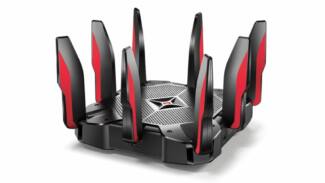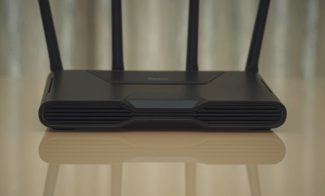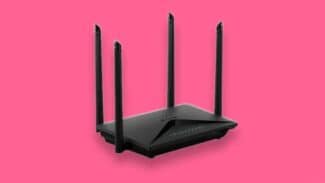Unfortunately, the application itself leaves a lot to be desired. It loads slowly and sometimes freezes, which is very annoying. Nevertheless, the program also presents the easiest way to update the router firmware.

- Best Gaming Routers of 2022
- 2022 Gaming Router Rating.
- Methodology
- How is a gaming router different from a regular router?
- Wireless network standards
- Rating
- Best for advanced users and gamers: the Asus ROG Rapture GT-AC5300
- TP-Link Archer C5400X
- Netgear XR1000.
- TP-Link Archer AX6000
- Linksys Hydra Pro
- What to look for in a gaming router
- Is it worth buying a gaming router?
Best Gaming Routers of 2022
Gaming routers are ideal for professional gamers and streamers who need high bandwidth to increase download and upload speeds. The best 2022 gaming routers are dual-band or even tri-band, allowing multiple users on the network to enjoy impressive download and upload speeds. Simply put, routers are responsible for directing data flow along the fastest paths to increase the efficiency of your network.
However, you may still experience lag even with a top-of-the-line router. It should be noted that routers do not have much effect on latency. If you have a low data rate from your ISP to the game server, a game router can't fix that. However, if you already have a decent ISP, a game router can improve your connection.
2022 Gaming Router Rating.
- The best router overall is the TP-Link Archer AX11000 tri-band Wi-Fi 6 router.
- Best budget router – ASUS AC2900 (RT-AC86U) gaming WiFi router.
- Best streaming router – TP-Link AC5400 tri-band Wi-Fi gaming router.
- Best mesh – NETGEAR Orbi's tri-band Wi-Fi 6 system for the whole house.
Methodology
With more than a decade of experience in selecting, configuring and managing gaming routers, we've been able to tell the difference between flashy, substandard products and true high-performance routers. We examined more than 30 high-end devices, including the TP-Link AC4000, the Asus RT AX86U, and the Asus ROG Rapture GT AC5300 gaming router, which didn't quite qualify. The most important factors we took into consideration included the quality of the device's Wi-Fi connection, the number of ports, the type of ports, and the maximum bandwidth.
We prioritized gaming routers that used the current Wi-Fi 6 network protocol standard because Wi-Fi 6 speeds are significantly faster than Wi-Fi 5. However, we made room for devices that could use multiple inputs and outputs (MU-MIMO) to communicate with multiple devices simultaneously.
We also looked for gaming routers with two or more LAN ports so that multiple devices can be directly connected to the router, allowing users to bypass finicky Wi-Fi signals.
After all, a device's maximum throughput indicates its true potential. We've highlighted maximum throughput as a key factor in distinguishing high-quality products from good-looking routers that only look great but don't have enough performance.
How is a gaming router different from a regular router?
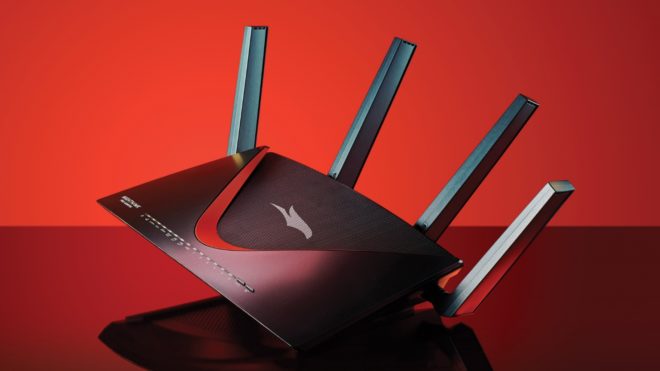
Many people have probably wondered – how is a gaming router different from a regular home internet router? Both devices are similar, but the key difference between a regular router and a gaming router is exactly how they work on the network.
A gaming router has the following features (in addition to those of a regular router):
- Faster connection to online game servers (lower ping and lower latency).
- Modern Wi-Fi standards.
- Multiple antennas.
- Additional Ethernet ports.
- Prioritization of gaming devices on the network over other home devices.
- Integration with IoT devices.
- Compatibility with IFTTT.
- Support for open source router firmware.
- Traffic prioritization.
One of the main features of a gaming router is the QoS (Quality of Service, or traffic prioritization) feature. Essentially, this means that the game router itself prioritizes the traffic and minimizes the effects of high network load.
This feature plays an important role in ensuring a smoother gaming experience with maximum frame rate and minimum latency. QoS minimizes data packet loss related to online gaming, in addition to safely routing all other inbound and outbound Internet traffic through a separate stream.
The latest routers, such as those with Qualcomm Stream Boost technology or others like it, ensure that gaming network traffic is safely routed to individual channels.
In addition, a gaming router differs from a regular router in that it can handle extreme network congestion and handle such situations more effectively.
Wireless network standards

This is a measure of which wireless standards a particular gaming router is designed for.
At the moment, the widely used wireless standard is 802.11ac, which is steadily replacing the WiFi6 version (802.11ax). You should keep in mind that wireless standards change over time, so it is important to choose a router that meets the latest wireless standards.
Rating
Best for advanced users and gamers: the Asus ROG Rapture GT-AC5300
One of the fastest routers among those tested. It has many useful game features, a variety of I/O ports, and a convenient management console where you can optimize network performance.
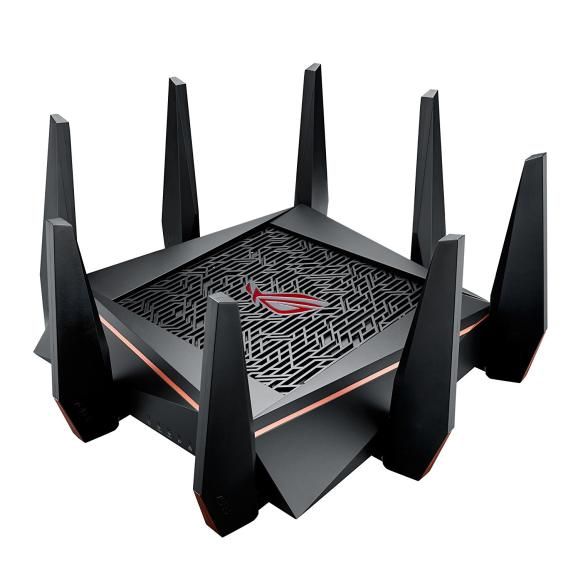
- High performance
- Gaming functionality
- 8 LAN ports
- Works with voice commands for Alexa assistant and IFTTT applets
- Sleek user interface
TP-Link Archer C5400X

Wi-Fi Specifications: 802.11ac/tri-band
Number of antennas/removable: 8/no.
Ports: 1 WAN, 8 1 Gbps LAN, 1 USB 2.0
Peak throughput: 859.5 Mbps
Size: 288x288x184 mm
The TP-Link Archer C5400X was once the best gaming router and is still the best choice for gamers who don't want to pay more for Wi-Fi 6.
Boasting some of the best 802.11ac performance you'll ever see in any single home networking device, it offers best-in-class tri-band speeds: 1 Gbps on the 2.4 GHz band and 2.167 Gbps on each of the two 5 GHz channels. It also has impressive coverage: more than 30 meters of superior coverage that will provide a strong and clear Wi-Fi signal in most homes.
The spider-like design with 8 antennas and red and black color scheme are sure to catch your eye, but the real advantage is the set of optimization and security features that will satisfy any power user.
With excellent bandwidth allocation controls that allow you to use the huge bandwidth at your own discretion, this router gives the user incredible performance for gaming or anything else.
Netgear XR1000.

Wi-Fi Specifications: Wi-Fi 6/double band
Number of antennas/removable: 4/yes
Ports: 1 WAN/4 LAN gigabit per second, USB 3.0
Peak throughput: 860.7 Mbps
Size:
- Maximum Wi-Fi 6 performance at medium distances
- Has anti-malware protection
- Good configuration settings
- Best gamer tools and interface
The Netgear Nighthawk Pro Gaming XR1000 is a powerful gaming router, with Wi-Fi 6 speeds that outperform most other gaming routers. Netgear's high-bandwidth, low-latency system features customization options and built-in security that provides protection from hackers along with superior Wi-Fi 6 performance.
It's also great for larger homes, with a range of 30 meters, easily covering the furthest room that other routers can't reach. If your current router doesn't meet your gaming needs, the XR1000 is one of the best gaming routers we've ever seen.
With an entire panel of configuration tools, you can optimize your router's performance in a staggering number of ways, from monitoring CPU usage to statistics that determine which apps and devices are using the most data, to connectivity tools that let you tune connections by ping speed and location.
TP-Link Archer AX6000

- Supported Wi-Fi standards: Wi-Fi 6 (802.11ac) and below
- Ports: 8 x GbE (LAN), 2.5GbE (WAN), USB 3.0 Type-A, USB 3.0 Type-C
- Operating frequency: 2.4 GHz, 5 GHz
- Additional Features: Tether mobile app, parental control, traffic prioritization, Alexa support
The TP-Link Archer AX6000 is the best router for gaming over a wired connection, as the model offers eight GbE (LAN) ports as well as the Wi-Fi 6 standard provided by the 2.5GbE (WAN) port.
This number of Ethernet inputs makes wired connectivity much easier, which tends to be more stable than even the best wireless connectivity (even if all the devices are in the vicinity).
Not to mention improved streaming on digital TV receivers, an improved Wi-Fi network supported by multiple wireless access points, and other benefits available from a wired connection setup.
TP-Link claims that the Archer AX6000 offers maximum data speeds of up to 4804 Mbps on the 5 GHz band and 1148 Mbps on the 2.4 GHz band, for a total of nearly 6000 Mbps.
Of course, these figures are in ideal conditions, and you can achieve such speeds only if the Internet provider will allow it.
Performance also depends on the number of devices connected to the network, but the built-in traffic prioritization technology (QoS) should make it easier to prioritize gaming equipment over other devices.
Read More:Other handy features of the Archer AX6000 include the companion Tether app, which can be used to configure the router, parental control software, support for Amazon Alexa voice assistant and built-in security tools.
Linksys Hydra Pro
- Supported Wi-Fi standards: Wi-Fi 6E and below
- Ports: 4 x GbE (LAN), 1 x 5GbE (WAN), USB 3.0
- Operating frequency: 2.4 GHz, 5GHz, 6GHz
- Advanced Features: Velop Intelligent Mesh technology, mobile app for configuration, built-in security tools
Linksys Hydra Pro is the best wireless router for gaming, because, in addition to supporting the Wi-Fi 6E standard, the model is equipped with a 5GbE port, which provides all the advantages of the most powerful Internet connections.
The developers claim that the Hydra Pro is capable of handling more than 55 connected devices simultaneously with a maximum coverage area of 250 square meters and data transfer rates of up to 6.6 Gbps.
Connection speeds at the most remote locations are expected to be quite slow, but Linksys promises that Velop Intelligent Mesh technology is "designed to provide gigabit Wi-Fi speeds in all corners of your home or office," so even remote devices should have fast connections – as long as you place multiple modules (mesh system).
The main drawback of the router is the limited number of ports. The device offers only four GbE (LAN) ports and one USB 3.0 Type-A port. This should be enough to connect several devices – presumably a PC or console – on which you plan to play.
At the same time you need to decide which devices will take full advantage of the high-speed wired connection. The same applies to a single USB port.
But if you don't plan to connect very many devices to your router via Ethernet, Wi-Fi 6E and mesh support will definitely make up for the small number of ports.
What to look for in a gaming router
While you're shopping for a gaming router, you should pay attention to what version of Wi-Fi it supports. The two main ones to look for are Wi-Fi 6 (802.11ax) – with Wi-Fi 6E extending Wi-Fi 6 to include the 6 GHz band – and Wi-Fi 5 (802.11ac), as they provide the highest wireless speeds currently available. When looking for a gaming router, you will undoubtedly come across devices designed for Wi-Fi 4 (802.11n), which look very attractive due to their low price, but you should avoid them. Wi-Fi 4 is an outdated standard that offers pretty low speeds compared to the two more modern versions.
You will also want to find a gaming router that is at least dual-band. Single-band routers only support the 2.4 GHz band, which is enough for browsing websites and downloading most files, but dual-band routers add a second 5 GHz channel, which provides much faster wireless speeds. You'll also find Tri-Band routers – and we've also featured some of them above – with an extra 5 GHz or 6 GHz band that you can devote entirely to gaming.
Is it worth buying a gaming router?
Why invest in a gaming router when you have a great router at home? You don't have to be a hardcore gamer to need one. Whether you love networking and collaborative gaming or download a lot of Steam games, gaming can monopolize some of your bandwidth, slowing down your network significantly.
However, a router designed specifically for gaming will not only provide a stable, uninterrupted connection, which is most important during your busiest gaming moments, but also allow you to prioritize the traffic to your computer and console. This will greatly improve your gaming experience (and loading speed) by minimizing latency and offering smoother graphics. It will also include technologies such as MU-MIMO and Quality of Service (or QoS) that will take your network to the next level when playing with or against players from around the world.
Households with multiple devices will also benefit, as gaming routers are better equipped to handle multiple devices and users using the network simultaneously.


